答案2010A考题食品科学概论双语
- 格式:doc
- 大小:84.00 KB
- 文档页数:8

2010年1月高等教育自学考试全国统一命题考试新型食品概论试卷课程代码:05766一、单项选择题:(本大题共20小题,每小题1分,共20分)1.为防止速冻蔬菜发生酶促褐变,速冻前对蔬菜进行( B )A.清洗处理B.烫漂处理C.浸渍处理D.沥水处理2.速冻食品最关键的贮藏条件是( A )A.贮藏室温度B.贮藏室湿度C.贮藏室空气流速D.贮藏室湿度波动3.保持食品色泽最好的干燥方法是( D )A.自然干燥B.热风干燥C.微波干燥D.冷冻干燥4.乳灭菌过程中,产生“蒸煮味”的物质硫化氢、硫化物等根本原因是蛋白质变性后产生的大量( D )A.氨基B.羧基C.羟基D.巯基5.UFT乳可能由于酶解导致脂肪上浮的酶是( B )A.酸性蛋白酶B.碱性蛋白酶C.中性蛋白酶D.巯基蛋白酶6.AIC清洗的目的是为了去除加热面上沉积的脂肪、蛋白质等垢层,降低系统内压力,对牛乳进行充分有效的杀菌,从而延长( D )A.系统稳定性B.系统平衡性C.系统加热时间D.系统运转时间7.食品工业中微波加热常用的频率是( C )A.50H ZB.915 H ZC.915MH ZD.1250MH Z8.微波灭酶的优点是( A )A.升温速度快B.产品风味好C.产品湿度大D.影响产品品质大9.微生物耐压能力由弱到强的顺序依次是( B )A.真菌、革兰阳性菌和革兰阴性菌B.真菌、革兰阴性菌和革兰阳性菌C.革兰阳性菌、革兰阴性菌和真菌D.革兰阴性菌、革兰阳性菌和真菌10.国际规定膨化食品中菌落总数不得超过( D )A.100000cfu/gB.80000cfu/gC.40000cfu/gD.10000cfu/g11.挤压膨化过程中,叶酸在100℃以上时的损失主要是( B )A.糊化作用B.氧化作用C.氢化作用D.脱水作用12.评价蛋白质营养价值的最重要指标是( D )A.食用率B.排泄率C.浸出率D.消化率13.粉末床法制得的微胶囊颗粒范围在( B )A.纳米级B.毫米级C.厘米级D.分米级14.下列选项中属于电渗析的基本部件是( C )A.微滤膜B.纳滤膜C.离子交换膜D.反渗透膜15.分子蒸馏分离过程所需要条件是( D )A.高压状态B.常压状态C.低真空状态D.高真空状态16.超临界CO2液体萃取技术可以从动物性食品中萃取出( C )A.蛋白质B.纤维素C.胆固醇D.碳水化合物17.一般只适用于实验室使用,在工业上已不采用的分子蒸馏设备是( B )A.离心式分子蒸馏器B.静止式分子蒸馏器C.旋转刮膜式分子蒸馏器D.自由降膜式分子蒸馏器18.面粉漂白是由于添加脂肪氧化酶使面粉中的不饱和脂肪酸氧化,进而氧化了面粉中的( C )A.花青素B.叶绿素C.胡萝卜素D.茜草素19.改变蛋白酶的专一性主要包括改变辅助因子的专一性、改变底物的专一性和( C )A.改变RNA结合专一性B.改变RNA降解专一性C.改变DNA结合专一性D.改变DNA降解专一性20.不允许在原料生产和产品加工过程中使用任何人工合成的农药、防腐剂等化学物质的食品是( D )A.普通食品B.无公害食品C.A级绿色食品D.有机食品二、多项选择题(本大题共5小题,每小题2分,共10分)21. 速冻蔬菜生产工艺的前处理阶段包括(ABCDE )A.原料采摘B.原料的运输C.原料的处理D.冷却E.布料22. 酶的改组技术通过定点诱变的方法,改变酶的氨基酸序列,以改变其(ACD )A.专一性B.溶解性C.催化性D.稳定性E.亲水性23. 不允许在有机食品中使用的色素有(ACE)A.朋脂红B.甜菜红C.苋菜红D.红曲红E.新红24. 管式膜组件有(ABCD)A.内压式B.外压式C.单管式D.管束式E.DDS式25. 从事绿色食品加工生产的人员不应患有的疾病有(ABCE )A.痢疾B.肝炎C.伤寒D.色盲E.结核三、名词解释题:(本大题共5小题,每小题3分,共15分)26.干耗:在食品的冻结过程中,一些水分从食品的表面蒸发出来,造成食品质量减少的现象。
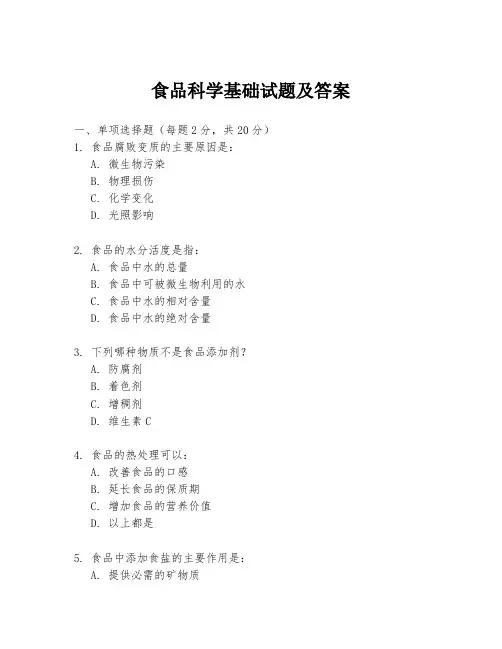
食品科学基础试题及答案一、单项选择题(每题2分,共20分)1. 食品腐败变质的主要原因是:A. 微生物污染B. 物理损伤C. 化学变化D. 光照影响2. 食品的水分活度是指:A. 食品中水的总量B. 食品中可被微生物利用的水C. 食品中水的相对含量D. 食品中水的绝对含量3. 下列哪种物质不是食品添加剂?A. 防腐剂B. 着色剂C. 增稠剂D. 维生素C4. 食品的热处理可以:A. 改善食品的口感B. 延长食品的保质期C. 增加食品的营养价值D. 以上都是5. 食品中添加食盐的主要作用是:A. 提供必需的矿物质B. 增加食品的风味C. 降低食品的水分活度D. 以上都是6. 食品中的微生物污染主要来源于:A. 空气B. 水C. 土壤D. 以上都是7. 食品的pH值对食品的保存性有重要影响,以下哪种食品的pH值通常较低?A. 面包B. 牛奶C. 苹果D. 柠檬8. 食品的冷冻保存可以:A. 完全杀死微生物B. 抑制微生物的生长C. 改变食品的营养成分D. 以上都是9. 食品的干燥处理可以:A. 增加食品的水分活度B. 降低食品的水分活度C. 提高食品的pH值D. 以上都不是10. 食品的辐射处理主要用于:A. 改变食品的颜色B. 延长食品的保质期C. 增加食品的营养成分D. 以上都不是二、多项选择题(每题3分,共15分)1. 食品的保存方法包括:A. 冷藏B. 冷冻C. 干燥D. 腌制2. 食品添加剂的主要作用包括:A. 改善食品的感官特性B. 延长食品的保质期C. 提高食品的营养价值D. 增加食品的安全性3. 食品中的微生物污染可能导致:A. 食品变质B. 食品中毒C. 食品营养流失D. 食品口感变差4. 食品的热处理方法包括:A. 煮沸B. 巴氏杀菌C. 紫外线照射D. 微波加热5. 食品的辐射处理可以用于:A. 杀死微生物B. 延长保质期C. 改变食品颜色D. 以上都不是三、判断题(每题1分,共10分)1. 食品的水分活度越低,微生物生长的可能性越小。
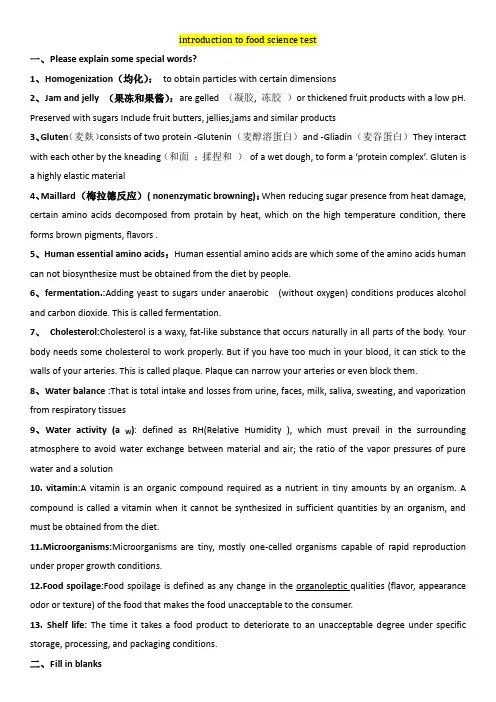
introduction to food science test一、Please explain some special words?1、Homogenization(均化):to obtain particles with certain dimensions2、Jam and jelly (果冻和果酱):are gelled (凝胶, 冻胶)or thickened fruit products with a low pH. Preserved with sugars Include fruit butters, jellies,jams and similar products3、Gluten(麦麸)consists of two protein -Glutenin (麦醇溶蛋白)and -Gliadin (麦谷蛋白)They interact with each other by the kneading(和面;揉捏和)of a wet dough, to form a ‘protein complex’. Gluten isa highly elastic material4、Maillard (梅拉德反应)( nonenzymatic browning):When reducing sugar presence from heat damage, certain amino acids decomposed from protain by heat, which on the high temperature condition, there forms brown pigments, flavors .5、Human essential amino acids:Human essential amino acids are which some of the amino acids human can not biosynthesize must be obtained from the diet by people.6、fermentation.:Adding yeast to sugars under anaerobic (without oxygen) conditions produces alcohol and carbon dioxide. This is called fermentation.7、Cholesterol:Cholesterol is a waxy, fat-like substance that occurs naturally in all parts of the body. Your body needs some cholesterol to work properly. But if you have too much in your blood, it can stick to the walls of your arteries. This is called plaque. Plaque can narrow your arteries or even block them.8、Water balance :That is total intake and losses from urine, faces, milk, saliva, sweating, and vaporization from respiratory tissues9、Water activity (a W): defined as RH(Relative Humidity ), which must prevail in the surrounding atmosphere to avoid water exchange between material and air; the ratio of the vapor pressures of pure water and a solution10. vitamin:A vitamin is an organic compound required as a nutrient in tiny amounts by an organism. A compound is called a vitamin when it cannot be synthesized in sufficient quantities by an organism, and must be obtained from the diet.11.Microorganisms:Microorganisms are tiny, mostly one-celled organisms capable of rapid reproduction under proper growth conditions.12.Food spoilage:Food spoilage is defined as any change in the organoleptic qualities (flavor, appearance odor or texture) of the food that makes the food unacceptable to the consumer.13.Shelf life: The time it takes a food product to deteriorate to an unacceptable degree under specific storage, processing, and packaging conditions.二、Fill in blanks1、Thanks to food science and technology and modern food manufacturing methods,nutritional deficiencies and inconsistent food availability can be addressed,harvests can be protected, and various commodities can be transformed into new products having specific nutrients for better health and wellness2、The main components in muscle are .Moisture Protein .Fat3、. the major Factors for fruit and vegetable deterioration are :①Enzymatic Changes; ②Chemical Changes; ③Physical Changes;④Biological Changes4、Enzymatic browning is usually undesirable when it occurs in foods such as apples, pears,lettuce(莴苣, 生菜), potatoes, etc.5、Sensory quality of fruit and vegetable will be changed chemically for lipid oxidation; non-enzymatic browning; colour changes; flavour changes.6、The four major factors which affect fruit and vegetable nutrient degradation are light, oxygen concentration, temperature and water activity.7、Leavening Agents used to produce gas in batters that make baked products rise are steam,yeast and baking soda and powder8、in bread process, the dough should be avoid of over fermentation, if not, it will make cause gluen stretch, become weak and collapse, while coarse grain & sour odor due to excess acid production and less color in baked crust面包皮; 糕饼等的酥皮9、Milk is the first food of young mammals. It provides a high-quality protein, a source of energy, and vitamins and minerals.10、Carbohydrates are chains of repeating molecules of glucose and other sugars.11、Proteins are made up of chains of amino acids. There are different amino acids in a protein.12、Fats are made up of lipids. A lipid has a structure of three fatty acids molecules and a glycerol (甘油,丙三醇)molecule.13、A peptide bond is a chemical bond formed between two molecules when the carboxyl group of one molecule reacts with the amine group of the other molecule, thereby releasing a molecule of water.14、Protein has a very big MW(molecular weight ), thus it can form hydrophilic colloid while protein is dissolved in water;15、Carbohydrates include monosaccharides; disaccharides; oligosaccharides and polysaccardies16、Natural Starch conformation is the mixture of amylose and amylopectin17、Vitamins are classified by their biological and chemical activity, not their structure.18、Vitamin divided by the solubility. Water-soluble vitamins (dissolve easily in water) 9 water-soluble (B1, 2, 3, 5, 6, 7, 9, 12 and C)19、Fat-soluble vitamins(absorbed through the intestinal tract with the help of lipids) 4 fat-soluble (A, D, E, K)20、The main groups of additives are: flavourings; colourings; preservatives and antioxidants; emulsifiers and stabilisers.21、Taste quality different from receptors for sweet, bitter, salty, sour, the 4 primary tastes, Cannot be reproduced by mixing of chemicals or of any of the 4 primary tastes22、Apart from adding flavourings to food enhances the taste , some other additives are used in food such as Colourings; Colourings;; Colourings ; Stabilizers23、the nutrition value of fat is that it can provide high energy , fat- soluble vitamin and essential fatty acid.24、fat have important role for food which be as carriers of flavor, advance food smooth texture and mouth feel, can be heat transfer.25、The microbial world comprised of 2 cellular types: (except virus) Eukaryotic cells (真核细胞, the Eucarya); Prokaryotic cells (原核细胞):26、Those microorganisms important in the food industry include the bacteria, viruses, yeasts, molds, and protozoans.27、Microorganisms growth curve in liquid has four phase: lag phase;exponential phase:stationary phase, decline phase:28、Growth of microorganisms can be manipulated by controlling some factors:①Nutrients available; ②Oxygen; ③Water; ④Temperature; ⑤Acidity and pH; ⑥Light; ⑦Chemicals29、Nutrients such as carbohydrates, nitrogen source(proteins) , energy source (such as fats ), growth factor (vitamins etc.), minerals and water, required by, mainly are also needed by microorganisms to grow.30、Factors affecting microbial growth in food preserve are Temperature; Relative humidity; Atmosphere; Modified atmosphere packaging (MAP)31、Food-borne illness (食源性病)----The sickness resulting from eating food contaminated with either bacterial toxins or by certain bacteria in the food, often resulting in vomiting(呕吐), diarrhea(腹泻)and prostration(衰竭、虚脱)32、Food-borne diseases (食源性病)are most often caused by several species of bacteria, although viruses, parasites(寄生生物), amoebas(阿米巴)and other biological as well as chemical agents may be responsible.三.please make the right choices .1、There are three kinds of muscles, which is mainly consumed and processed?(1)Skeletal muscles(骨骼肌,横纹肌), ()(2)Smooth muscles(平滑肌),(3)Heart muscles(心肌).2、The main component part is protein except water to take up 18%~20%,80% solid in meat , Muscle Proteins can be classifild to three kinds, that is(1)Myofibrillar proteins(肌原纤维蛋白质)(2)Sarcoplasmic proteins(肌浆蛋白)(3)Stroma proteins(肉基质蛋白质)3、which is not Berries?(1)Grape (2)strawberry (3)coconut( √)4、which is not Pip fruits(仁果类果实)(1) apple, (2) pear, (3)chestnut(板栗)( √)5.which is not Foliar vegetables(叶菜类)?(1)spinach(菠菜),(2)celery芹菜(3)potato6.which is Floscular vegetables (花菜类)?(1)broccoli n. 甘蓝;花椰菜( √)(2)tomato番茄(3)mushroom7.Physical methods of reducing fruit and vegetable deteriorate(1)Heating (2)Cooling(3)Lowering of water content (drying/dehydration).√8.Physical methods of reducing fruit and vegetable deteriorate(1)Controlled and modified atmosphere storage(2) Irradiation(辐射)(3)Waxing(蜡封)of the surfa(水面)9.Chemical Methods of reducing fruit and vegetable deteriorate(1)Salting (2)Sugar addition (3)Canning10.Chemical Methods of reducing fruit and vegetable deteriorate(1)Artificial acidification (2)Ethyl alcohol addition (乙醇添加)(3)Antiseptic substance action(防腐剂作用)11、which are kinds of common used Flour(1)All-purpose flour(普通面粉;家用面粉;中筋面粉)(2)Cake flour(低筋面粉;蛋糕粉;细面粉)(3)Instant/quick-mixing flour(快速混合面粉)12、which are kinds of common used Flour(1)Instant/quick-mixing flour(快速混合面粉)(2)Self-rising flour(自发面粉----已含酵母的)(3)Whole wheat flour(全麦面粉)13、Fluids which do not obey Newton viscosity law are non-newtonian fluids. For example: (1)tomato puree (2)sour milk, (3)grease.14.What molecules are foods made of?1.Carbohydrates 2、water 3、Vitamins.15、What molecules are foods made of?1.proteins 2、fats 3、minerals16、Agents causing denaturation1 .Temperature 2. pH 3.Ionic strength (salts)17. Agents causing denaturation1. Enzymes2. Heat3. Oxidation18.Which one is hydrophilic gelatum?1.Tofu ()2.Soy-bean milk3.albumen(白蛋白)19. Which one is not hydrophilic colloid?1.albumen(白蛋白)2.tendon ( )k,20.which is not essential amino acid for human?1.methionine,2.lysine3.glutamic acid ( )21.which is essential amino acid for human?1.lysine ( )2.glutamic acid3.proline22. which is disaccharides:1.Maltose麦芽糖2.Frucose ( )ctose乳糖23. Which is not monosaccharides :1.Glucose2.Sucrose蔗糖( )3. Galactose半乳糖24.Whichm mineral is not major salt component?1.potassium,钾2.sodium,钠3.Al ( )25.Whichm mineral is major salt components1.Fe,2.Cu,3.calcium,钙( )26.The reasons for vitamin deficiency:(1) Shortage of resource ( ) (2) Reduced absorption ( )(3) Increase requirements ( )27.Which are Water-soluble vitamins include1.Vitamin A2.vitamin B ( )3.vitamin C. ( )28.Which are fat-soluble vitamins include1.Vitamin D ( )2.vitamin E ( )3.vitamin B29. Vitamins have diverse biochemical functions:Hormones (③),Antioxidants (④),Mediators of cell signaling and regulators of cell and tissue growth and differentiation (①),Precursors for coenzymes (②)①Vitamin A;②Vitamin B;③vitamin D;④Vitamin E30.which Microorganisms are Eukaryotic cells真核细胞1.fungi2.yeast ( )3.bacteria31.which Microorganisms are Prokaryotic cells (原核细胞):1.Bacteria ( )2.actinomyces放线菌3.yeast酵母菌32.Fermentation selects for the growth of one or more bacteria which then inhibit the growth of harmful microbes. Fermentation food is1.yogurt, ( )2.cheese, ( )3.buttermilk ( )33.These fermentation foods include,1 soy sauce, ( )2 alcoholic beverages, and ( ) 3.vinegar. ( )四、Please answer Yes or No after each items .1.Without fat, all meats taste almost the same! (√)2. During Rigor Mortis process,the cells will continue to produce energy (ATP) by breaking down glycogen reserves, which produces lactic acid, dropping the pH to 5.2-5.6. (√)3. Waxing of the surface retards the rate of moisture loss, and maintains turgor (皮肤饱满)and plumpness(丰满度;肥胖度)and may modify the internal atmosphere(√)4.Modified atmosphere packaging of strawberries (carbon dioxide-enriched air delays fungal growth延迟真菌生长(√)5Flour composition critical (面粉成分标准)for the fermentation and physical structure of the dough and finished bread. (√)6Flour-Usually “all purpose flour” used for baking breads. Main function is to give structure to the bread. (√)7Almost all of the gluten forms during the kneading stage. It is important to not add too much extra flour while kneading. This will make the dough far too stiff (硬的).8、The role of milk in nature is to nourish(滋养)and provide immunological protection for the mammalian young. (√)9.Changing the shapes of proteins also changes their properties. They become easier to digest and moreuseful to the cells of the human body. (√)10. To make proteins, a cell must have all needed amino acids available simultaneously (√)11.If the diet supplies too little of any essential amino acid , protein synthesis is limited. (√)12.Biological value can be improved by feeding two or more low quality protein feeds together if they are complimentary(√)13.Overfeeding on protein does not increase the amino acid level, starvation does not decrease it(√)14.Amino acids will be sacrificed to provide energy and glucose if needed when glucose and fatty acids are limited(√)k, fruit, vegetables, meat, soups and sauces can all be dehydrated to stop them from spoiling(√)16.Water Activity large effect on chemical reactions and microbial growth rate(√)17.Sodium ions are necessary for regulation of blood and body fluids, transmission of nerve impulses, heart activity, and certain metabolic functions. (√)18.Severe dehydration(脱水) will lead to very high blood sodium concentrations,but too rapid correction may result in brain damage from cellular swelling. (√)19.Microorganisms, like other living organisms, are dependent on their environment to provide for their basic needs. Adverse conditions can alter their growth rate or kill them. ( √)20.Microorganisms growth changing with temperature would gain high quality and quantity products during process ( √)21.A spoiled food is not necessarily unsafe to eat, but unpalatable(味道差的) to the consumer. Foods are attacked in a variety of ways that are harmful to the quality of the food ( √)五、Please give the answer for each Question.1.what does the course of Introduction to Food Science (UK) focus on ?Introduction to Food Science (UK) is the required course for food science and engineering major , mainly Introducting and reviewing to food ingredients, processing, package, market and storage and their complex relationship in bilingual language (English and Chinese ), while it is explored that how these factors affect the quality and safety of food.2.what is the request for students after course ?after the course, students should understand and master the basic components of food and the most commonly process , technology and equipment used in food processing , integrating the professional talent necessary to develop advanced products basing on the professional theory and professional English, which is the basis for students entering the higher grades to learn more advanced theory and more specialized knowledge.3.what the concepts of food science and technology ?Food Science is the discipline in which the engineering, biological, and physical sciences are used to study the nature of foods, the causes of deterioration, the principles underlying food processing, and the improvement of foods for the consuming public.Food Technology is the application of food science to the selection, preservation, processing, packaging, distribution, and use of safe, nutritious, and whole some food.In practice, the terms food science and food technology are often used interchangeably.4.How important is fat in food?fat has some nutrition value as essential fatty acids to provide high energy, which be adventage for fat-soluble vitamin. Fat is good for carriers of flavor, smooth texture and mouth feel, while it is heat transfer media.5、what are requirements on varieties used for processing?(1)To consider of the yield, supply period, storage time, edible part ratio, physical quality, chemical compositions and sensory quality when choosing fruits and vegetables(2)The texture, chemical composition, yield, processing characteristics and harvesting time are closely related to the variety of fruits and vegetables(3)The fruits used for processing should follow the requirements below: high acid,adequate ratio of sugar to acid, small core and stone, rich pulp(果肉), tight and micromesh(细致的)texture, strong heat endurance, bigger percentage of edible part, and with good color, aroma and taste.(4)The vegetables used for processing should be rich in pulp(果肉), have tender and micromesh texture, less crude fiber, much edible part and good color.6. The standards for a good variety of fruit and vegetable:①Stable and yield.②Long period’s supply.③Convenient to mechanized farming and harvesting④Strong resistance to plant diseases and insect pets,long storage time,good adaptability.⑤Sensory quality meets there quirements of processing.7.What are the Enzymic Changes for fruit and vegetable ?Oxidation of phenolic substances (苯酚) by phenolase (苯酚酶) (leading to enzymatic browning酶促褐变);• Sugar - starch conversion by amylases(淀粉酶);• Post-harvest demethylation(脱甲基化)of pectic substances (果胶物质)8.What are the principles thof Preservation that sugar used in jam and jelly can prevent the growth of microorganisms?(1)Add sugar to increase osmotic pressure(渗透压)to prevent microorganism development.(2)In food preservation with sugar, water activity can’t be reduced < 0.845 --- sufficient for bacteria andyeast inhibition, but does not prevent mold attack.9.what is gluten and How about is it in bread process?Gluten consists of two protein: -Glutenin (麦醇溶蛋白)and -Gliadin (麦谷蛋白)• They interact with each other by the kneading(和面;揉捏和)of a wet dough, to form a ‘protein complex• Gluten is a highly elastic material–Protein complex gives bread structure and elasticity and essential doe the leavening process–Poorly formed or absent in nonwheat flours–Most commercial breads contain some wheat10、How does baking powder make cakes rise?Baking powder contains:sodium hydrogencarbonate (碳酸氢钠). When this is heated during cooking it breaks down into sodium carbonate, carbon dioxide gas and water.---It is the carbon dioxide gas that makes the cakes rise.11、Yeast makes bread rise?!1.Yeast is a type of fungus. It is used to make bread rise. Bread is usually made from wheat flour. As yeast digests the carbohydrates in flour it produces carbon dioxide.2.Making bread from yeast is an aerobic reaction. This means it needs oxygen.3.Once the yeast has been added, the uncooked dough is left to rise.12、What is the chemistry of milk?The principal constituents of milk are water, fat, proteins, lactose (milk sugar) and minerals (salts). Milk also contains trace amounts of other substances such as pigments, enzymes, vitamins, phospholipids (substances with fatlike properties), and gases.Cows’milk consists of about 87% water and 13% dry substance. The dry substance is suspended or dissolved in the water.13.Why do eggs look different before or after cooked?Eggs are a protein food and so are made up of amino acids. When eggs are cooked they become firmer. This is because cooking eggs changes the shape of the amino acids chains. This is called denaturing.14.what is the protain isoelectric point ?At isoelectric point (specific for each protein),positive charges = negative charges →total charge = 0No charge –no repulsion –clotting of protein – e.g. production of dairy products (milk isoelectric point at pH 4.5)15.how about is the results after that enzymes act on protein ?1.Proteolytic enzymes (pepsin(胃蛋白酶), rennin(凝乳酶), trypsin(胰蛋白酶)) hydrolyze peptide bonds of protein →can lead to large changes in structure & function2.Desirable & undesirable changes during processing & storage of proteins3.Lead to changes in peptide side chains, make some amino acids unavailable, indigestible16、what is the most common food proteins in our daily food?Egg white, blood usually contain albumin白蛋白, but myofibrillar protein(肌纤维蛋白)is from Actin, myosin(肌球蛋白)in muscles.Gluten(谷蛋白、麸质或面精)in wheat can make dough good structure for bread making. most Connective tissue inLigaments(韧带), fibrous contains much more collagen(胶原蛋白), while milk protein mainly is casein(酪蛋白).17、What is the physiological functions of proteins & amino acids?Composition of body, improve growth• Composition of enzymes and hormone, regulate biological function• Form antibody, improve the immune-activity of body• Regulate osmotic pressure, otherwise protein-energy malnutrition.• Supplement of energy• Keep the flexible of skin• Transport fat, iron, oxygen and CO218、What is Physiologic roles of Lipids and Fats?(1).Source of energy (during sustained activity)1 g food lipid can produce 37.7kJ (9kcal) energy in body.(2). Structure of cell membrane.(3). maintain body temperature normally.(4). Protect viscera (脏器) from harmful.(5).Play some role in endocrine(内分泌作用).(6).Offer essential fatty acid. Such as linolie acid亚油酸, linolenic acid -亚麻酸。
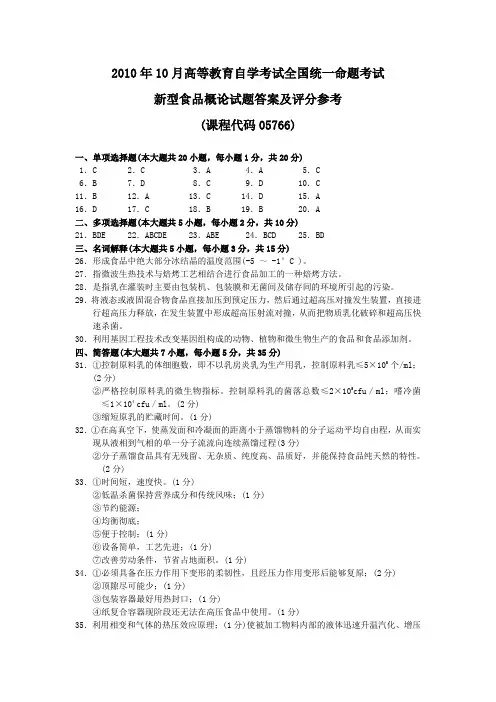
2010年10月高等教育自学考试全国统一命题考试新型食品概论试题答案及评分参考(课程代码05766)一、单项选择题(本大题共20小题,每小题1分,共20分)1.C 2.C 3.A 4.A 5.C6.B 7.D 8.C 9.D 10.C11.B 12.A 13.C 14.D 15.A16.D 17.C 18.B 19.B 20.A二、多项选择题(本大题共5小题,每小题2分,共10分)21.BDE 22.ABCDE 23.ABE 24.BCD 25.BD三、名词解释(本大题共5小题,每小题3分,共15分)26.形成食品中绝大部分冰结晶的温度范围(-5 ~ -1°C )。
27.指微波生热技术与焙烤工艺相结合进行食品加工的一种焙烤方法。
28.是指乳在灌装时主要由包装机、包装膜和无菌间及储存间的环境所引起的污染。
29.将液态或液固混合物食品直接加压到预定压力,然后通过超高压对撞发生装置,直接进行超高压力释放,在发生装置中形成超高压射流对撞,从而把物质乳化破碎和超高压快速杀菌。
30.利用基因工程技术改变基因组构成的动物、植物和微生物生产的食品和食品添加剂。
四、简答题(本大题共7小题,每小题5分,共35分)31.①控制原料乳的体细胞数,即不以乳房炎乳为生产用乳,控制原料乳≤5×105个/ml;(2分)②严格控制原料乳的微生物指标。
控制原料乳的菌落总数≤2×105cfu/ml;嗜冷菌≤1×104 cfu/ml。
(2分)③缩短原乳的贮藏时间。
(1分)32.①在高真空下,使蒸发面和冷凝面的距离小于蒸馏物料的分子运动平均自由程,从而实现从液相到气相的单一分子流流向连续蒸馏过程(3分)②分子蒸馏食品具有无残留、无杂质、纯度高、品质好,并能保持食品纯天然的特性。
(2分)33.①时间短,速度快。
(1分)②低温杀菌保持营养成分和传统风味;(1分)③节约能源;④均衡彻底;⑤便于控制;(1分)⑥设备简单,工艺先进;(1分)⑦改善劳动条件,节省占地面积。
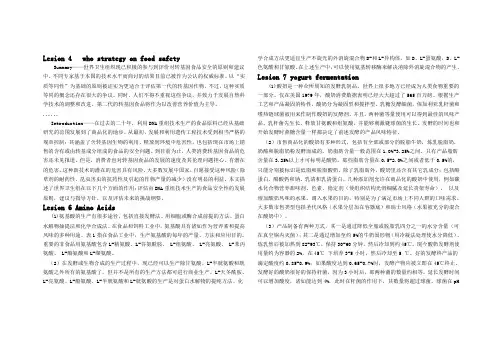
Lesion 4 who strategy on food safetySummary——世界卫生组织现已积极的参与到评价对转基因食品安全的原则和建议中。
不同专家基于本国的技术水平而商讨的结果目前已被作为公认的权威标准。
以“实质等同性”为基础的原则被证实为更适合于评估第一代的转基因作物。
不过,这种实质等同的概念还存在很大的争议。
同时,人们不得不重视这些争议,并致力于发展自然科学技术的调整和改进。
第二代的转基因食品将作为以改善营养价值为主导,......Introduction——在过去的二十年,利用DNA重组技术生产的食品原料已经从基础研究的范围发展到了商品化的地步。
从最初,发展和利用遗传工程技术受到相当严格的规章控制;其涵盖了含转基因生物的利用、释放到环境中危害性,也包括现在市场上销售的含有或由转基成分组成的食品的安全问题。
到目前为止,人类消费转基因食品的危害还未见报道。
但是,消费者也对转基因食品的发展的速度及其伦理问题担心。
有潜在的危害。
这种新技术的潜在的危害具有风险。
大多数发展中国家,自愿接受这种风险(除草剂的耐药性、昆虫害虫的抗药性及引起的作物产量的减少)没有明显的利益。
本文描述了世界卫生组在以下几个方面的作用:评估由DNA重组技术生产的食品安全性的发展原则,建议与指导方针,以及评估未来的挑战纲要。
Lesion 6 Amino Acids(1)氨基酸的生产有很多途径,包括直接发酵法、用细胞或酶合成前提的方法、蛋白水解物抽提法和化学合成法。
在食品和饲料工业中,氨基酸具有诸如作为营养素和提高风味的多种用途。
表1指在食品工业中,生产氨基酸的每年的产量、方法和应用目的。
重要的非食品用氨基酸包含L-精氨酸、L-谷氨酰胺、 L-组氨酸、 L-亮氨酸、 L-苯丙氨酸、 L-酪氨酸和L-缬氨酸。
(2)在发酵或生物合成的生产过程中,现已经可以生产除甘氨酸、L-半胱氨酸和胱氨酸之外所有的氨基酸了,但并不是所有的生产方法都可进行商业生产。
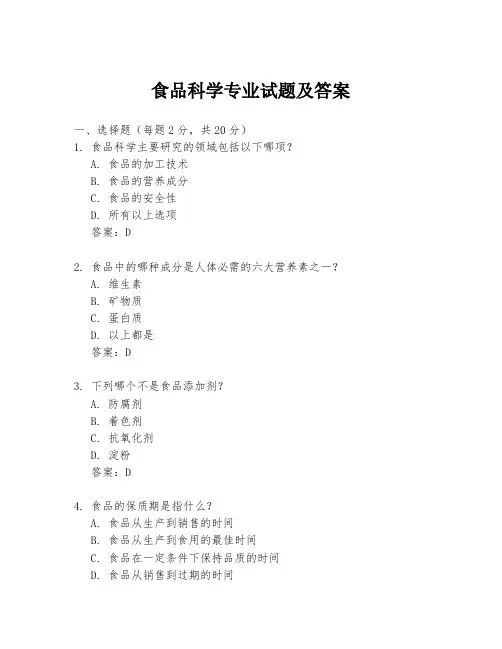
食品科学专业试题及答案一、选择题(每题2分,共20分)1. 食品科学主要研究的领域包括以下哪项?A. 食品的加工技术B. 食品的营养成分C. 食品的安全性D. 所有以上选项答案:D2. 食品中的哪种成分是人体必需的六大营养素之一?A. 维生素B. 矿物质C. 蛋白质D. 以上都是答案:D3. 下列哪个不是食品添加剂?A. 防腐剂B. 着色剂C. 抗氧化剂D. 淀粉答案:D4. 食品的保质期是指什么?A. 食品从生产到销售的时间B. 食品从生产到食用的最佳时间C. 食品在一定条件下保持品质的时间D. 食品从销售到过期的时间答案:C5. 食品科学中,HACCP代表什么?A. 危害分析和关键控制点B. 高级食品化学分析C. 健康和安全控制程序D. 人类应用化学控制答案:A...(此处省略其他选择题,共10题)二、填空题(每空1分,共10分)1. 食品腐败变质的主要原因是_________的大量繁殖。
答案:微生物2. 食品加工过程中,常用的杀菌方法包括_________和_________。
答案:热处理、辐射3. 食品的感官评价主要包括_______、_______、_______、_______和_______。
答案:色泽、香气、味道、口感、形态...(此处省略其他填空题,共5空)三、简答题(每题10分,共20分)1. 简述食品加工过程中常见的食品污染源有哪些?答案:食品加工过程中常见的污染源包括原料污染、加工设备污染、操作人员污染、环境污染以及包装材料污染等。
2. 食品中的营养成分主要包括哪些?答案:食品中的营养成分主要包括碳水化合物、脂肪、蛋白质、维生素、矿物质和水等。
四、论述题(每题15分,共30分)1. 论述食品科学在食品安全管理中的作用。
答案:食品科学在食品安全管理中扮演着至关重要的角色。
它通过研究食品的组成、性质、加工、储存和运输等环节,确保食品在生产、加工、销售和消费的整个链条中保持安全和卫生。
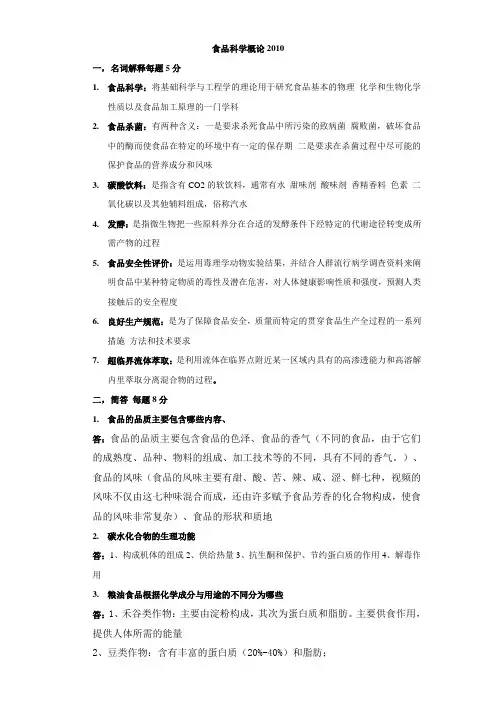
食品科学概论2010一,名词解释每题5分1.食品科学:将基础科学与工程学的理论用于研究食品基本的物理化学和生物化学性质以及食品加工原理的一门学科2.食品杀菌:有两种含义:一是要求杀死食品中所污染的致病菌腐败菌,破坏食品中的酶而使食品在特定的环境中有一定的保存期二是要求在杀菌过程中尽可能的保护食品的营养成分和风味3.碳酸饮料:是指含有CO2的软饮料,通常有水甜味剂酸味剂香精香料色素二氧化碳以及其他辅料组成,俗称汽水4.发酵:是指微生物把一些原料养分在合适的发酵条件下经特定的代谢途径转变成所需产物的过程5.食品安全性评价:是运用毒理学动物实验结果,并结合人群流行病学调查资料来阐明食品中某种特定物质的毒性及潜在危害,对人体健康影响性质和强度,预测人类接触后的安全程度6.良好生产规范:是为了保障食品安全,质量而特定的贯穿食品生产全过程的一系列措施方法和技术要求7.超临界流体萃取:是利用流体在临界点附近某一区域内具有的高渗透能力和高溶解内里萃取分离混合物的过程。
二,简答每题8分1.食品的品质主要包含哪些内容、答:食品的品质主要包含食品的色泽、食品的香气(不同的食品,由于它们的成熟度、品种、物料的组成、加工技术等的不同,具有不同的香气。
)、食品的风味(食品的风味主要有甜、酸、苦、辣、咸、涩、鲜七种,视频的风味不仅由这七种味混合而成,还由许多赋予食品芳香的化合物构成,使食品的风味非常复杂)、食品的形状和质地2.碳水化合物的生理功能答:1、构成机体的组成2、供给热量3、抗生酮和保护、节约蛋白质的作用4、解毒作用3.粮油食品根据化学成分与用途的不同分为哪些答:1、禾谷类作物:主要由淀粉构成,其次为蛋白质和脂肪。
主要供食作用,提供人体所需的能量2、豆类作物:含有丰富的蛋白质(20%-40%)和脂肪;3、油料作物:包含油菜、芝麻、向日葵、大豆与花生等,含有丰富的脂肪(25%-50%),其次是蛋白质(20%-40%)4、薯类作物:也成根茎类作物,特点是块根或块茎中含有大量的淀粉,包括甘薯、木薯、马铃薯等。
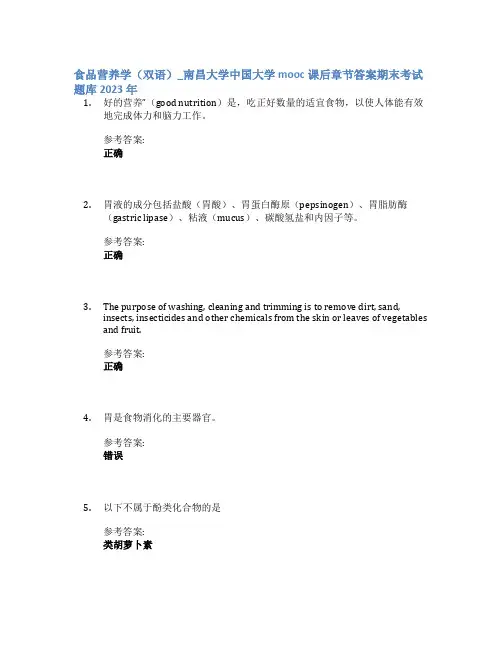
食品营养学(双语)_南昌大学中国大学mooc课后章节答案期末考试题库2023年1.好的营养”(good nutrition)是,吃正好数量的适宜食物,以使人体能有效地完成体力和脑力工作。
参考答案:正确2.胃液的成分包括盐酸(胃酸)、胃蛋白酶原(pepsinogen)、胃脂肪酶(gastric lipase)、粘液(mucus)、碳酸氢盐和内因子等。
参考答案:正确3.The purpose of washing, cleaning and trimming is to remove dirt, sand,insects, insecticides and other chemicals from the skin or leaves of vegetables and fruit.参考答案:正确4.胃是食物消化的主要器官。
参考答案:错误5.以下不属于酚类化合物的是参考答案:类胡萝卜素6.植物化学物可以分为参考答案:Phenolic compounds_Terpenes_Alkaloid_S-containing compounds7.以下哪种食物单位重量的能量最高?参考答案:sugar8.以下哪些是能量的单位:参考答案:KJ_Kcal_cal9.成年人的能量消耗主要包括哪三部分?参考答案:基础能量消耗_活动的能量消耗_食物热效应10.抗氧化物质是人体必需营养素。
参考答案:错误11.食品营养学是农业科学、食品科学与营养科学有机结合的交叉学科。
参考答案:正确12.以下哪些是影响基础代谢率的主要因素?参考答案:瘦体质_性别和年龄_内分泌和应激状态_生活作业环境13.双标水测定法是间接测定能量的方法。
参考答案:正确14.营养素为机体提供能量、构建和维持体组织、调节机体的各种生理过程参考答案:正确15.()is slightly higher than UL, to ensure most people intake adequatenutrients.参考答案:RAD16.以下哪个氨基酸不是必需氨基酸参考答案:甘氨酸17.Which could not through mammary gland to milk?()参考答案:Iron18.Protein from food or a protein supplement acts the same in the body.参考答案:正确19.妊娠糖尿病是妊娠早期可能出现的一种糖尿病症状。
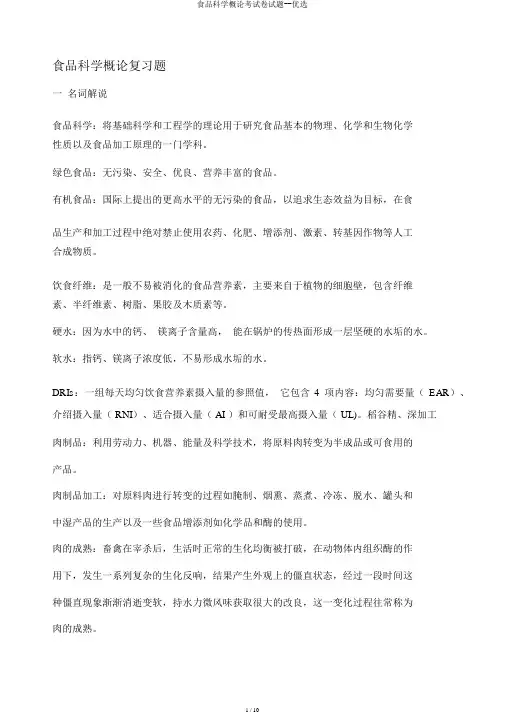
食品科学概论复习题一名词解说食品科学:将基础科学和工程学的理论用于研究食品基本的物理、化学和生物化学性质以及食品加工原理的一门学科。
绿色食品:无污染、安全、优良、营养丰富的食品。
有机食品:国际上提出的更高水平的无污染的食品,以追求生态效益为目标,在食品生产和加工过程中绝对禁止使用农药、化肥、增添剂、激素、转基因作物等人工合成物质。
饮食纤维:是一般不易被消化的食品营养素,主要来自于植物的细胞壁,包含纤维素、半纤维素、树脂、果胶及木质素等。
硬水:因为水中的钙、镁离子含量高,能在锅炉的传热面形成一层坚硬的水垢的水。
软水:指钙、镁离子浓度低,不易形成水垢的水。
DRIs:一组每天均匀饮食营养素摄入量的参照值,它包含4 项内容:均匀需要量(EAR)、介绍摄入量( RNI)、适合摄入量( AI )和可耐受最高摄入量( UL)。
稻谷精、深加工肉制品:利用劳动力、机器、能量及科学技术,将原料肉转变为半成品或可食用的产品。
肉制品加工:对原料肉进行转变的过程如腌制、烟熏、蒸煮、冷冻、脱水、罐头和中湿产品的生产以及一些食品增添剂如化学品和酶的使用。
肉的成熟:畜禽在宰杀后,生活时正常的生化均衡被打破,在动物体内组织酶的作用下,发生一系列复杂的生化反响,结果产生外观上的僵直状态,经过一段时间这种僵直现象渐渐消逝变软,持水力微风味获取很大的改良,这一变化过程往常称为肉的成熟。
PSE 肉:俗称灰白肉,其颜色黯淡(灰白),pH值及系水力较低,肌肉组织柔软并伴有大批渗水症候,嫩度微风味较差。
DFD肉:是肉猪宰后肌肉pH 值高达以上 , 形成暗红色、质地坚硬、表面干燥的干硬肉。
乳制品:原料乳经过加工后所得的产品,主要品种有饮用乳、奶粉、炼乳、干酪、奶油和再制奶,此中以消毒鲜奶、奶粉、酸奶为大宗产品。
(果实)成熟:果实经过一系列的生长发育,达到最正确食用阶段时称为成熟。
(果实)衰老:果实走向个体发育的最后阶段,组织开始分解,细胞崩溃,器官死亡。
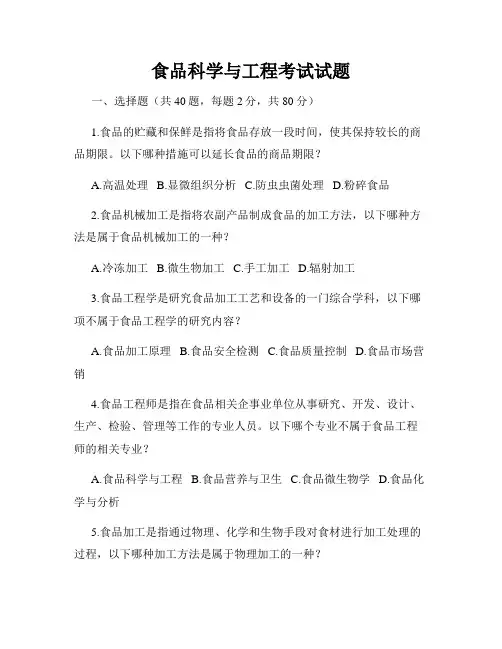
食品科学与工程考试试题
一、选择题(共40题,每题2分,共80分)
1.食品的贮藏和保鲜是指将食品存放一段时间,使其保持较长的商品期限。
以下哪种措施可以延长食品的商品期限?
A.高温处理
B.显微组织分析
C.防虫虫菌处理
D.粉碎食品
2.食品机械加工是指将农副产品制成食品的加工方法,以下哪种方法是属于食品机械加工的一种?
A.冷冻加工
B.微生物加工
C.手工加工
D.辐射加工
3.食品工程学是研究食品加工工艺和设备的一门综合学科,以下哪项不属于食品工程学的研究内容?
A.食品加工原理
B.食品安全检测
C.食品质量控制
D.食品市场营销
4.食品工程师是指在食品相关企事业单位从事研究、开发、设计、生产、检验、管理等工作的专业人员。
以下哪个专业不属于食品工程师的相关专业?
A.食品科学与工程
B.食品营养与卫生
C.食品微生物学
D.食品化学与分析
5.食品加工是指通过物理、化学和生物手段对食材进行加工处理的过程,以下哪种加工方法是属于物理加工的一种?
A.酶解
B.酸化
C.冷冻
D.发酵
二、填空题(每题2分,共20分)
1.生物降解是指生物体利用外源性物质作为能量来源并转化为自身所需物质的能力,其中最常见的生物降解物质为(1)和(2)。
答:(1)有机物(2)生物质。
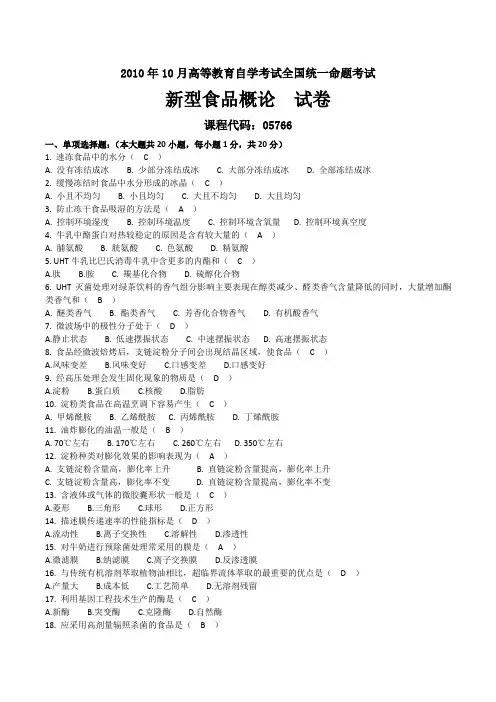
2010年10月高等教育自学考试全国统一命题考试新型食品概论试卷课程代码:05766一、单项选择题:(本大题共20小题,每小题1分,共20分)1. 速冻食品中的水分( C )A. 没有冻结成冰B. 少部分冻结成冰C. 大部分冻结成冰D. 全部冻结成冰2. 缓慢冻结时食品中水分形成的冰晶( C )A. 小且不均匀B. 小且均匀C. 大且不均匀D. 大且均匀3. 防止冻干食品吸湿的方法是( A )A. 控制环境湿度B. 控制环境温度C. 控制环境含氧量D. 控制环境真空度4. 牛乳中酪蛋白对热较稳定的原因是含有较大量的( A )A. 脯氨酸B. 胱氨酸C. 色氨酸D. 精氨酸5. UHT牛乳比巴氏消毒牛乳中含更多的内酯和( C )A.肽B.胺C. 羰基化合物D. 硫醇化合物6. UHT灭菌处理对绿茶饮料的香气组分影响主要表现在醇类减少、醛类香气含量降低的同时,大量增加酮类香气和( B )A. 醚类香气B. 酯类香气C. 芳香化合物香气D. 有机酸香气7. 微波场中的极性分子处于( D )A.静止状态B. 低速摆振状态C. 中速摆振状态D. 高速摆振状态8. 食品经微波焙烤后,支链淀粉分子间会出现结晶区域,使食品( C )A.风味变差B.风味变好C.口感变差D.口感变好9. 经高压处理会发生固化现象的物质是( D )A.淀粉B.蛋白质C.核酸D.脂肪10. 淀粉类食品在高温烹调下容易产生( C )A. 甲烯酰胺B. 乙烯酰胺C. 丙烯酰胺D. 丁烯酰胺11. 油炸膨化的油温一般是( B )A. 70℃左右B. 170℃左右C. 260℃左右D. 350℃左右12. 淀粉种类对膨化效果的影响表现为( A )A. 支链淀粉含量高,膨化率上升B. 直链淀粉含量提高,膨化率上升C. 支链淀粉含量高,膨化率不变D. 直链淀粉含量提高,膨化率不变13. 含液体或气体的微胶囊形状一般是( C )A.菱形B.三角形C.球形D.正方形14. 描述膜传递速率的性能指标是( D )A.流动性B.离子交换性C.溶解性D.渗透性15. 对牛奶进行预除菌处理常采用的膜是( A )A.微滤膜B.纳滤膜C.离子交换膜D.反渗透膜16. 与传统有机溶剂萃取植物油相比,超临界流体萃取的最重要的优点是( D )A.产量大B.成本低C.工艺简单D.无溶剂残留17. 利用基因工程技术生产的酶是( C )A.新酶B.突变酶C.克隆酶D.自然酶18. 应采用高剂量辐照杀菌的食品是( B )A.土豆B.干香葱粉C.草莓D.大蒜19. 一个蛋白质的三维结构在最大程度上依赖于侧链间的( B )A.共价键B.非共价键C.疏水键D.氢键20. 中国国家环境保护总局有机食品发展中心的简称是( A )A.OFDCB.OQDCC.OFACD.OUDC二、多项选择题(本大题共5小题,每小题2分,共10分)21. 利用解冻介质解冻的方法有(BDE)A.电解冻B.空气解冻C.微波解冻D.压缩空气解冻E.水解冻22. UHT乳的设备是一个密闭的系统,乳被泵入系统后,在流经途中的加工单元包括( ABCDE)A.预热B.高温冷却C.均质D.冷却E.无菌包装23. 采用挤压膨化技术生产的食品有(ABE)A.锅巴B.人造肉C.面包D.油条E.虾条24. 膜分离的推动力有(BCD)A.速度梯度B.浓度梯度C.压力梯度D.电势梯度E.温度梯度25. 在食品工业中常用的微波频率有(BD)A. 815MHzB. 915MHzC. 1450MHzD. 2450MHzE. 3450MHz三、名词解释题:(本大题共5小题,每小题3分,共15分)26.最大冰结晶生成带:形成食品中绝大部分冰结晶的温度范围(-5~-1℃)。
食品专业英语试题及答案一、选择题(每题2分,共20分)1. The term "shelf life" in food science refers to the period during which a food product is expected to remain:A. FreshB. EdibleC. UnchangedD. All of the above2. Which of the following is not a common food additive?A. PreservativesB. EmulsifiersC. Flavor enhancersD. Natural sugars3. The process of ________ is used to kill bacteria in food products.A. FermentationB. PasteurizationC. CanningD. Drying4. The unit "ppm" stands for:A. Parts per millionB. Pounds per minuteC. Percentage point marginD. Per pound mass5. In food processing, the term "HACCP" refers to:A. Hazard Analysis and Critical Control PointsB. High Accuracy Control ProgramC. Health and Community Care ProgramD. High-altitude Cooking and Cooling Process6. The main purpose of using enzymes in food production is to:A. Increase the nutritional valueB. Enhance the flavorC. Improve the textureD. Accelerate the reaction rate7. Which of the following is a method of food preservation?A. FreezingB. SmokingC. Both A and BD. None of the above8. The chemical formula for table salt is:A. NaClB. KClC. CaCl2D. MgCl29. The "five senses" in sensory evaluation of food do not include:A. TasteB. SmellC. SightD. Temperature10. The term "rancidity" in food science is associated with the oxidation of:A. ProteinsB. CarbohydratesC. LipidsD. Vitamins二、填空题(每空1分,共10分)11. The ________ is a technique used to determine the fat content in meat products.(Infra-red spectroscopy)12. A ________ is a person who is trained to evaluate food products using their senses.(Sensory panelist)13. The ________ is the process of removing water from food to extend its shelf life.(Dehydration)14. The ________ is a type of food spoilage caused by the growth of mold.(Mycotoxin)15. The ________ is a method used to preserve food by using high temperatures and pressure.(Sterilization)16. The ________ is the study of the chemical, physical, and biological properties of food.(Food science)17. The ________ is a technique used to detect the presence of specific microorganisms in food.(Microbiological analysis)18. The ________ is a food additive that helps to maintain the color of food products.(Antioxidant)19. The ________ is a process used to remove impurities from food products.(Purification)20. The ________ is the study of the changes in food during processing and storage.(Food chemistry)三、简答题(每题10分,共20分)21. What are the main functions of food additives in the food industry?Answer: The main functions of food additives include preserving food to prevent spoilage, enhancing the flavor and texture of food, improving the appearance of food, and providing nutritional benefits.22. Describe the steps involved in the HACCP system.Answer: The HACCP system involves seven steps: 1) Assess the hazards associated with the food; 2) Determine thecritical control points; 3) Establish critical limits for each control point; 4) Monitor the control points to ensure they are within the limits; 5) Corrective actions if thelimits are exceeded; 6) Verify that the HACCP system is working effectively; 7) Record keeping for all the steps and actions taken.四、论述题(每题25分,共50分)23. Discuss the importance of food safety and the role of regulatory bodies in ensuring it.Answer: Food safety is crucial to prevent foodborne illnesses and protect public health. Regulatory bodies play a key role by setting standards, monitoring compliance, conducting inspections, and enforcing regulations to ensure that food products are safe for consumption.24. Explain the concept of "sustainable food production" and its significance in today's world.Answer: Sustainable food production refers to thepractice of producing food using methods that protect the environment, public health, and community well-being while ensuring long-term food security. It is significant in。
最新精选全文完整版(可编辑修改)《食品专业英语》考试试卷(A卷)一、指出下列前后缀或词汇含义(每小题1.5中译英:英译中:半- iso-两- poly-亚- mono-酵母菌的发酵bio-乙醇hydrogen bond化学防腐剂biocatalyst溶解度polar solvents脱水hydrocarbon果胶sugar and starch氧化spoilage二、选择题(每小题2分,共10分)1. Proteins are of great size, complexity, and diversityA. atomsB. moleculesC. protonD. ion2. The word is often paired with the word food because the two go gogether. They are interdependent, but not interchangeable.A. starchB. lipidC. nutritionD. sugar3. Esters of fatty acids with alcohols is .A. simple lipidsB. compound lipidsC. derived lipidsD. hydrocarbons4. are the “ building blocks” of proteins.A. peptidesB. amino acidC. enzymesD. lipid5. The fungi, consist of two major microorganisms, and yeasts.A. moldsB. bacteriaC. microbeD. cocci三、英译汉(每小题7分,共35分)1.Remember that catalysts increase the rate of a reaction, but are not themselves consumed or produced by the reaction. Also, they do not change the equilibrium constant (平衡常数)of a reaction.2. These are enzymes that catalyze the reduction or oxidation of a molecule. Remember that oxidation is the reverse(逆反应)ofreduction.3. The vitamins are divided into two general categories based on their solubility in either water or fat. The fat-soluble vitamins are vitamins A, D, E and K; the water -soluble vitamins include vitamin C and vitamin B.4. Each of these nutrients contains carbon, hydrogen, and oxygen, while protein also contains nitrogen, and it is the ratio of carbon to hydrogen to oxygen that determines the number of calories(热量)they provide.5. They are called essential nutrients because we cannot get along without them. We need them for energy, for building and maintaining body tissue, and for regulating body processes- the three essential functions of foods in the body.四、汉译英(共25分)1、化学添加剂可用于防止由微生物引起的食品腐败。
食品科学概论习题及解答doc概念题:1、食物:人体生长发育、更新细胞、修补组织、调节机能必不可少的营养物质,也是产生热量保持体温、进行体力活动的能量来源,即可供人类食用的含有营养素的天然生物体,或称富含营养素的物质的总称食品:经特定方式加工后供人类食用的食物食品加工:以农产品、畜产品及水产品等为主要原料,采用物理、化学、生物等方法,获得更具价值、满足人类需求的食品。
保藏加工/初级加工:资源保藏目的,尽可能采用非常态条件,以减少原料中的营养素损失。
产品加工/精深加工:产品开发目的,尽可能采用各种技术与设备,以生产品种繁多的色香味俱全的食品,丰富我们人类的物质生活类的物质生活2. 营养素:食物中可给人体提供能量、机体构成成分和组织修复以及生理调节功能的化学成分。
必需营养素(必需氨基酸、牛磺酸,必需脂肪酸、 EPA、 DHA)牛磺酸:是一种特殊的氨基酸,主要存在于肌肉、血小板、发育的神经(中枢)系统内。
参与谷氨酸构成,被认为是一种神经递质,初乳中丰富。
半胱氨酸在体内氧化并脱羧的产物,可与胆汁酸结合生成胆汁盐。
3. 主料:食品加工中用量较大、未经深加工过的农副产品(包括糖、面、油、肉、蛋、奶等)辅料/配料:深加工过的用量较小的农副产品。
可分为淀粉、变性淀粉、淀粉糖、糖醇、低聚糖、蛋白类等。
食品添加剂:指为改善食品的品质和风味,或者为了加工工艺和贮存的需要,在食品加工过程中加入食品中少量的天然或化学合成物质。
食品添加剂主要有着色剂(改变食品外观)、调味剂(增加食品的味道)、防腐剂(防止食品腐烂变质)、营养强化剂(增强食品的营养价值)。
食品安全卫生法(GB2706)对使用食品添加剂的剂量有着严格限制。
食品添加剂的正确使用有三大原则:使用标准、剂量等在GB2760内找的到;使用的对象要说明;使用的限量有明确要求。
只有同时满足这三大原则,才可以安全的使用食品添加剂。
4. 营养金字塔/膳食营养宝塔:人为制造出的像金字塔形状的为应对人生理特征而做的一个黄金三角,为了指导人们合理营养。
2010年攻读硕士研究生入学考试试题一、名词解释(共7小题,每小题5分,共35分)1、食品科学2、食品杀菌3、碳酸饮料4、发酵5、食品安全性评价6、良好生产规范7、超临界萃取二、简答题(共7题,每题8分,共56分)1、食品品质主要包括哪些内容?2、碳水化合物的生理功能?3、粮油食品根据化学成分与用途的不同分为哪些?4、水产品加工原料种类。
5、食品腐败变质的原因主要有哪些?6、HACCP的基本原理包含?7、食品感观评价的方法有哪些?三、论述题(共5小题,50分)1、干燥过程中食品物料的主要变化。
(9分)2、食品常见的保藏技术和原理有哪些?(11分)3、食品添加剂的发展趋势?(11分)4、食品包装常用材料及优缺点?(13分)5、生物技术在食品工业中主要有哪些应用?(15分)2011年攻读硕士研究生入学考试试题一、名词解释(共5小题,每小题5分,共25分)1、水分活度2、酶促褐变3、淀粉糊化4、脂肪酸败5、食源性疾病二、简答题(共5题,每题15分,共75分)1、简述淀粉老化的机理。
2、食品科学的五个框架。
3、HACCP基本原理。
4、你对食用色素的看法。
5、食品中非蛋白氮的测定方法。
三、论述题(共2小题,每小题25分,共50分)1、列举3种食品成分的现代分离技术,叙述每种技术的原理和优缺点。
2、列举3种非热杀菌技术,叙述每种杀菌的原理和优缺点。
2012年攻读硕士研究生入学考试试题一、名词解释(共5小题,每小题5分,共25分)1、酶工程2、淀粉老化3、水分活度4、ISO5、功能性食品二、简答题(共5题,共75分)1、叙述发酵食品的四大优点。
(12分)2、食品科学的概念、研究内容。
(18分)3、简述我国居民膳食指南。
(16分)4、简述HACCP的基本原理。
(14分)5、列举三种维生素,并转述其生理功能。
(15分)三、论述题(共2小题,每小题25分,共50分)1、叙述你对食品添加剂看法。
2、列举3种非热杀菌技术,叙述每种杀菌的原理和优缺点。
西北农林科技大学
2010 年攻读硕士学位研究生入学考试
食品化学试题
环状糊精球蛋白酶促褐变蛋白质变性烟点水分活度绝对阈值持水力美拉德反应发色剂蛋白质凝胶
二、简答题
1.酪蛋白磷肽的功能。
2.美拉德反应对食品品质的影响。
3.膳食纤维的保健功能。
4.影响油脂塑性的因素。
5.影响乳状液稳定性的因素。
6.影响面团形成的因素。
7.变性对蛋白质活性和功能的影响。
8.常见影响矿物质利用性的因素。
9.MSI曲线中各区水的特性。
三、反应题
1.美拉德反应的过程。
2.三价铁对脂肪氧化的机理。
四、论述题
1.食品污染种类和现代检测技术。
2.水分活度、氧气、PH、温度及其他成分对V
影响。
C。
食品科学概论(A卷参考答案)一、名词解释(每小题2分,共12分)功能性食品:其成分对人体能充分显示防御功能,调节生理节律以及预防疾病和促进康复等有关身体调节功能的加工食品ISO (International Standard Organization):国际标准化组织超临界流体萃取:超临界流体萃取(Supercritical Fluid Extraction,缩写SCFE)是利用流体(溶剂)在临界点附近某一区域(超临界区)内所具有的高渗透能力和高溶解能力萃取分离混合物的过程。
冷冻干燥:冷冻干燥又称真空冷冻干燥、升华干燥、冷冻升华干燥、分子干燥等,它是先将湿物料的温度降至冰点以下,使物料中的水分凝结成冰,然后在较高的真空度下,使冰直接升华而除去水分的干燥方法细胞工程:所谓细胞工程(Cell Engineering)是指以细胞为基本单位,在体外条件下进行培养、繁殖或人为地使细胞的某些生物学特性按人们的意志发生改变,从而达到改良生物品种和创造新品种,加速动物或植物个体的繁殖或获得某些有用的物质的过程。
它包括了动物和植物细胞的体外大量培养技术、细胞融合技术(也称细胞杂交技术)、细胞拆分、染色体工程和繁殖生物学技术等。
膜分离:膜分离(Membrane Separation)是利用具有一定选择透过性的过滤介质,依靠其两侧存在的能量差作为推动力,利用混合物中各组分在过滤介质中迁移速率的不同来实现物质的分离与纯化的单元操作二、填空题(每空1分,共10分)我国健康人群碳水化合物供给量以供给热能①60%~70%为宜,我国18~65岁的居民平均粮食消费每年在②112~169kg之间为宜;我国健康人群脂肪供给量成年人占总热量的③20%~25%为宜,这个热量相当于每日供给④58~72g脂肪(包括食物中脂肪和烹调用油);我国健康人群蛋白质供给量成年人占总热量的⑤15%~20%为宜,这个热量相当于每日供给⑥80~90g蛋白质;目前一般认为⑦亚油酸和⑧α-亚麻酸为人体必需脂肪酸;维生素A又叫⑨视黄醇,如缺乏维生素A引起⑩夜盲症三、没有食品就没有人类,食品的重大变化推动着人类的进化和发展,推动着人类文明的迈进。
食品2008级食品科学试题A标准答案及评分标准Ⅰ. 单项选择题(请把正确答案前的字母填入题后的括号内,错选、漏选、多选均不得分,每题1分,共15分)7.浓缩牛奶进行正常喷雾干燥时,若进口空气温度为200℃,出口空气温度为120℃,牛奶的进料温度为55℃,则奶粉微粒在干燥过程中受热的最高温度和下面的哪一个温度Ⅱ. 多项选择题(请把正确答案前的字母填入题后的括号内,错选、漏选、多选均不得分,每题1分,共5分)Ⅲ.什么是食品科学?简述其主要包括哪些内容。
(10分)是研究食品的一门科学。
是将基础学科和工程学的理论用于研究食品基本的物理、化学和生物化学性质以及食品加工原理的一门学问。
食品科学技术学科是以食品工业——食品加工业、食品制造业、饮料制造业、烟草加工业所依托的科学理论问题的研究、工程技术及装备的实现和相关科研、工程队伍的组织和培养——为其基本内涵。
首先,如果在专业名称中带“科学”两字表示该专业属理科类,毕业时一般获理学学位,如果带“工程”二字表示该专业属工科类,毕业时获工学学位。
1、食品科学是以现代科学、技术与工程为基础,以食品生产、加工、包装、贮藏、流通、消费、环保等为其主要研究内容,以食品卫生、营养、感官品质等食品质量及其变化、维护、检验、评价等为研究中心,并与现代管理科学、人文科学、市场营销等学科有密切的联系,现代食品科学已发展为一门跨学科的综合性科学。
主要研究内容包括:●食品质量研究包括食品质量构成;食品质量变化;食品质量控制、品质保持和质量管理等等。
●食品安全包括食品安全与健康、食品风险分析、食品安全性评价与食品安全指标体系;转基因食品与生物安全。
●食品分析与检验包括感官检验、理化检验和卫生检验。
●食品消费包括食物结构,平衡膳食设计,食品消费规律和影响食品消费的各种因素。
●食品与环境包括环境对食品所造成的各种污染以及食物生产、加工和包装废弃物等对环境的污染。
重点研究绿色食品、有机食品和清洁生产。
●食品贸易与技术壁垒学生毕业后,一般在技术监督部门、流通部门、外贸部门、环保、海关、商检、包装、生产、检验等企事业单位从事实际工作,或在高等院校或科研机关从事教学和科研工作。
食品科学是一门涉及食品微生物学、食品分析、食品工程和食品化学等多范围的学科。
A背景知识:⑴食品科学概述;⑵化学回顾;⑶食品化学;⑷营养与消化;⑸食品组分;⑹食品的质量要素;⑺食品加工中的单元操作;⑻食品变质。
B保藏方法:⑴热保藏;⑵冷藏;⑶干燥和脱水;⑷食品的辐射、微波、和欧姆加工;⑸发酵、微生物和生物技术;⑹化学品;⑺包装。
C食品的种类:⑴乳;⑵肉、禽、蛋;⑶海产品;⑷谷物、豆类和油料种子;⑸蔬菜和水果;⑹油脂;⑺糖果制品;⑻饮料。
D相关问题:⑴环境意识和加工;⑵食品安全;⑶法规与标签管理制度;⑷世界食品需求⑸食品科学的职业。
Ⅳ. Explanation of terms (2 point each, in total 10 points)1. HACCP,危害分析与关键控制点:是一个预防性的食品安全系统,首先对食品生产过程的每一个环节进行危害分析,找出工艺中的关键控制的潜在问题点,在问题发生前,对问题点设置严格质量控制措施的一种方法。
2. Logarithmic Order of Death,对数死亡法则:在通常的加热条件下,在给定的时间间隔内,不论剩余细菌总数的多少,被杀灭的细菌的百分数是相同的。
或者:热杀菌时,在一定温度下,在同样的时间间隔内,微生物死亡的百分数相同。
或者:细菌受热致死的速度基本上正比于受热体系中活菌的数量。
3. SCP,单细胞蛋白:某些经过筛选的微生物,如酵母,含有丰富的营养可以用作动物饲料或人类食品,被称为单细胞蛋白。
4. cocoa,可可粉:是由可可豆精细研磨成粉、脱脂、烘烤、加入天然或人工香料而制成。
5. BOD,(Biological Oxygen Demend)即生物需氧量:在一定条件下(一般在20℃下保温5d)需氧微生物使废水或污水不再发生变化时的需氧量(mg/kg)。
答对主要意思即可得满分。
Ⅴ. Fill in the blank. (0.5 point each, 25 points total)1. Food processing is the largest manufacturing industry in the world.2.Irradiation cannot be used with dairy products and some fruits, such as peachesand nectarines.3. Microwaves heat foods by generating heat inside the food due to water friction.4. Dehydration results in decreased weight and volume of a product and shipping costs.5. Ultrafiltration is a membrane filtration process operating at 2 to 10 bars pressure and allowing molecules the size of salts and sugars to pass through the membrane pores, while molecules the size of proteins are rejected.6. The principle of freeze-drying is that under conditions of low vapor pressure (vacuum), water evaporates from ice without the ice melting.7. The purpose of drying is to remove enough moisture to prevent microbial growth.8. Dried foods are not sterile. Many spores survive in dry areas of food.Drying never completely removes all water.9. Refrigerated storage requires low temperatures, air circulation, humidity control, and modified gas atmosphere.10. Enzymes will maintain a certain level of activity during freezing.11. Packaging for frozen foods protects against dehydration, light, and air.12. Four types of preservatives achieved by heating are sterilization, commercial sterility, pasteurization, and blanching.13. Heating before packaging requires aseptic (germ-free) packaging.14. To pick the right heat treatment severity for a specific food, two factors must first be determined: time-temperature combination required to inactivate the most resistant microbe; heat penetration characteristics of the food and the container.15. The three general categories of food deterioration are: physical, chemical, and biological.16. All foods undergo deterioration. All foods have a time limit of their usefulness—shelf life.17. Food-borne disease is any disease resulting from the consumption of food.18. Some fruits and vegetables are washed to remove internal heat and cool immediately after being picked in order to minimize post-harvest biochemical changes.19. Food flavor is a combination of taste and smell.20. Consumers expect certain qualities from their food. These include color, flavor, texture, and even size.21. Protein provides essential amino acids, and nitrogen for the synthesis of other nitrogen-containing compounds.22. A monosaccharide may have 5or 6carbons. A disaccharide is made of two monosaccharides.23. Fat soluble vitamins include vitamins A, D, E, and K.24. Salt is an example of a/an ionic bond.25.Seven product lines along which the food industry is divided are cereal and bakery products; meat, fish, and poultry;dairy products; fruits and vegetables; sugars and other sweets; fats and oils; beverages.Ⅵ. Short answer questions. (3 point each, 15 points total)1. What are the two requirements for irradiation.Two requirements for the irradiation process include:A source of radiant energy;A way to confine that energy.辐射能量的来源控制能量的方法2. List three chemical changes that occur during drying.Several chemical changes can occur during drying, including: caramelization, enzymatic browning, nonenzymatic browning, loss of ease of rehydration, loss of flavor.3. What are the two main objectives of pasteurization?Destroy all pathogenic microorganisms that might grow in a specific product; Extension of shelf life by decreasing number of spoilage organisms present.4. Give four preservation techniques to prevent food deterioration.Food preservation involves the use of heat, cold, drying, acid, sugar and salt, smoke, atmosphere, chemicals, radiation, and mechanical methods.1.What is the difference between what plain teas and herbal teas are made from?什么是普通茶和草本植物(代用)茶的区别?A(431): 普通茶来自于茶树叶,并含有咖啡因;草本茶来自于许多植物的叶、花、根、bark皮、种子,并不含咖啡因。